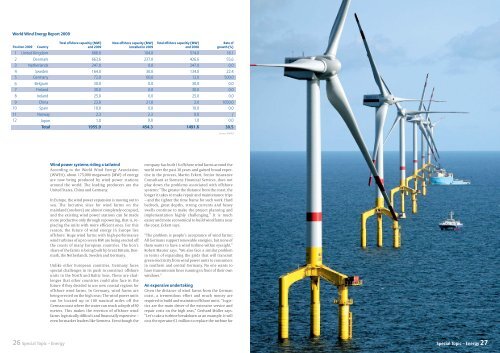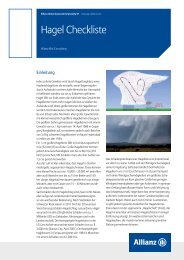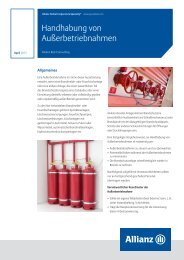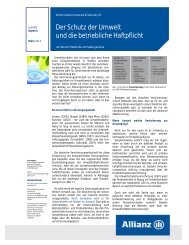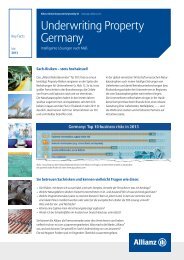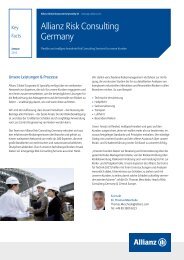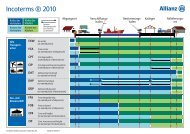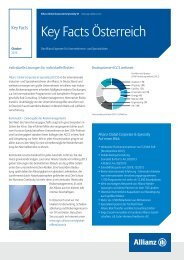Energy - Allianz Global Corporate & Specialty
Energy - Allianz Global Corporate & Specialty
Energy - Allianz Global Corporate & Specialty
Create successful ePaper yourself
Turn your PDF publications into a flip-book with our unique Google optimized e-Paper software.
World Wind <strong>Energy</strong> Report 2009<br />
Position 2009 Country<br />
1 United Kingdom 688.0 104.0 574.0<br />
2 Denmark 663.6 237.0 426.6<br />
3 Netherlands 247.0 0.0 247.0<br />
4 Sweden 164.0 30.0 134.0<br />
5 Germany 72.0 60,0 12.0<br />
6 Belgium 30.0 0.0 30.0<br />
7 Finland 30.0 0.0 30.0<br />
8 Ireland 25.0 0.0 25.0<br />
9 China 23.0 21.0 2.0<br />
10<br />
Spain 10.0 0.0 10.0<br />
11<br />
12<br />
26 Special Topic – <strong>Energy</strong><br />
Total offshore capacitiy (MW)<br />
end 2009<br />
New offshore capacity (MW)<br />
installed in 2009<br />
Wind power systems riding a tailwind<br />
According to the World Wind <strong>Energy</strong> Association<br />
(WWEA), about 175,000 megawatts (MW) of energy<br />
are now being produced by wind power stations<br />
around the world. The leading producers are the<br />
United States, China and Germany.<br />
In Europe, the wind power expansion is moving out to<br />
sea. The lucrative sites for wind farms on the<br />
mainland (onshore) are almost completely occupied,<br />
and the existing wind power stations can be made<br />
more productive only through repowering, that is, re -<br />
placing the units with more efficient ones. For this<br />
reason, the future of wind energy in Europe lies<br />
offshore: Huge wind farms with high-performance<br />
wind turbines of up to seven MW are being erected off<br />
the coasts of many European countries. The lion’s<br />
share of the farms is being built by Great Britain, Denmark,<br />
the Netherlands, Sweden and Germany.<br />
Unlike other European countries, Germany faces<br />
special challenges in its push to construct offshore<br />
units in the North and Baltic Seas. These are chal -<br />
lenges that other countries could also face in the<br />
future if they decided to use new coastal regions for<br />
offshore wind farms. In Germany, wind farms are<br />
being erected on the high seas: The wind power units<br />
can be located up to 100 nautical miles off the<br />
German coast where the water can reach a depth of 60<br />
meters. This makes the erection of offshore wind<br />
farms logistically difficult and financially expensive –<br />
even for market leaders like Siemens. Even though the<br />
Total offshore capacitiy (MW)<br />
end 2008<br />
Rate of<br />
growth (%)<br />
Norway<br />
2.3<br />
2.3<br />
0.0<br />
22.4<br />
500.0<br />
0.0<br />
0.0<br />
0.0<br />
1050.0<br />
0.0<br />
/<br />
Japan<br />
1.0<br />
0.0<br />
1.0<br />
0.0<br />
Total 1955.9 454.3 1491.6 30.5<br />
18.1<br />
55.6<br />
0.0<br />
Source: WWEA<br />
company has built 16 offshore wind farms around the<br />
world over the past 20 years and gained broad expertise<br />
in the process, Martin Eckert, Senior Insurance<br />
Consultant at Siemens Financial Services, does not<br />
play down the problems associated with offshore<br />
systems: “The greater the distance from the coast, the<br />
longer it takes to make repair and maintenance trips<br />
– and the tighter the time frame for such work. Hard<br />
bedrock, great depths, strong currents and heavy<br />
swells continue to make the project planning and<br />
implementation highly challenging.” It is much<br />
easier and more economical to build wind farms near<br />
the coast, Eckert says.<br />
“The problem is people’s acceptance of wind farms:<br />
All Germans support renewable energies, but none of<br />
them wants to have a wind turbine within eyesight,”<br />
Robert Maurer says. “We also face a similar problem<br />
in terms of expanding the grids that will transmit<br />
green electricity from wind power units to consumers<br />
in southern and central Germany. No one wants to<br />
have transmission lines running in front of their own<br />
windows.”<br />
An expensive undertaking<br />
Given the distance of wind farms from the German<br />
coast, a tremendous effort and much money are<br />
required to build and maintain offshore units. “Logistics<br />
are the main driver of the extensive service and<br />
repair costs on the high seas,” Gerhard Müller says.<br />
“Let’s take a turbine breakdown as an example. It will<br />
cost the operator € 1 million to replace the turbine for<br />
Special Topic – <strong>Energy</strong> 27


